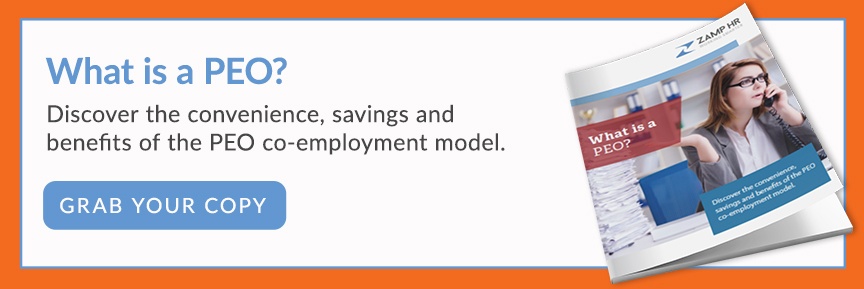Employers look to employee benefit plans to entice prospective, top-tier candidates in today’s tight job market. When it comes to retaining valued employees, many name retirement benefits as a reason to stay with their current employer.
Nevertheless, sponsoring retirement plans also means administrative turmoil for unprepared employers. This happens because employers as plan sponsors owe a duty to administer and manage retirement plans prudently. If plan sponsors do not act prudently, they incur sole liability for avoidable plan losses. An employer’s sole liability directly results from the law’s imposition of sole fiduciary liability on retirement plan sponsors.
The good news is that employers can reduce risk by outsourcing fiduciary responsibilities. Outsourcing creates a co-fiduciary relationship. The only HR outsourcing arrangement that engenders this co-fiduciary status is a Professional Employer Organization (PEO).
Read on to learn how selecting a retirement plan maintained by a PEO means you alleviate plan sponsor stress as experts make the plan’s investment decisions.
What is a fiduciary?
The Employee Retirement Income Security Act of 1974 (ERISA) requires that retirement plans state one or more Named Fiduciaries in the plan document. A Named Fiduciary controls plan operation and administration, particularly investments. The Named Fiduciary stated in the plan document may include an individual or a group of people.
Functional fiduciaries, on the other hand, are not named in the retirement plan document. They have fiduciary responsibility by virtue of their control and authority over the plans:
- Assets,
- Investments, and
- Administration.
Other people not ordinarily considered plan fiduciaries may become fiduciaries by straying into the fiduciary territory by accident while carrying out their professional or other duties, such as:
- Accountants,
- Attorneys,
- Consultants, and
- Staff employees.
Fiduciaries must follow specific rules set out under ERISA. They are set forth below.
- Exclusive Benefit Rule - the responsibility to solely pay pension benefits to participants and defray reasonable plan expenses;
- Prudent Expert Rule - the fiduciary must carry out duties with the care, skill, and due diligence that a prudent person would employ if familiar with the matter and in similar circumstances. In the case of investments, the standard is the prudent and knowledgeable investor;
- Diversification Rule - the fiduciary must diversify investment choices to minimize investment losses; and
- Duty to Follow Plan Terms - the fiduciary must act according to the plan document provisions and in accordance with ERISA.
What is a co-fiduciary?
ERISA not only imposes fiduciary liability on fiduciaries for their own actions. ERISA also imposes co-fiduciary liability on a fiduciary for the breaches of fellow plan fiduciaries. This is the case even when the blameless person has no fiduciary status over the breached plan feature. In other words, if you see a fellow fiduciary’s action as hurtful to the plan, say something. The prudent fiduciary in this situation must take all legal and reasonable steps to stop the fiduciary breach. To do otherwise, will result in you being held for the fiduciary breach as well.
The shared responsibilities between the PEO as co-fiduciary and the employer are set forth in the PEO’s Client Service Agreement (CSA). The employer retains oversight of its staff members. The PEO describes the employer’s staff as PEO employees for purposes of paying taxes and complying with employment legislation and regulatory guidance.
What are the benefits of naming a co-fiduciary?
There are benefits to naming a co-fiduciary for your employees’ retirement plan, such as limiting liability. When co-fiduciaries share the fiduciary responsibilities, then the liability is no longer solely yours.
Limiting liability is crucial within the context of preventing a breach of the diversification rule relative to investments. If the retirement plan experiences immense financial losses due to failure to diversify investments, ignorance is not an available defense.
ERISA Compliance
Hiring experts to make the fiduciary’s decisions concerning investments fulfills the ERISA requirement under the Prudent Expert Rule. ERISA makes it incumbent upon plan sponsors to track all changes to retirement-related laws at the federal, state, and local levels. Such monitoring may pose a significant burden on smaller HR staff, especially small or medium-sized employers. Hiring a Prudent Expert makes the monitoring responsibility easier.
Objective Assessment
Hiring an independent co-fiduciary eliminates the specter of a conflict of interest when selecting retirement plans and plan providers. For example, conflicts of interest may arise in the following investment management areas:
- Portfolio management;
- Investment advice;
- Custodial duties;
- Exercise of voting rights;
- Redeeming investment; and
- Sales of investment funds.
With a PEO as the co-fiduciary, making the objective assessment regarding investment decisions transfers some liability to the PEO.
Why choose a PEO as your co-fiduciary?
Along with the advantages listed above, outsourcing to a PEO as your co-fiduciary partner comes with unique benefits to your business. Some of those advantages include:
- Offer Fortune 500 benefits to your employees;
- Leave administrative details to the PEO, so you can do what you do best: grow your business;
- Realize savings on employee benefits and workers’ compensation;
- Increase your employees’ productivity;
- Upgrade HR processes and the latest HR technology while saving money; and
- Limit fiduciary liability and investment risk.
Above all, relax in the knowledge that your plan will stay compliant with federal, state, and local laws and regulatory guidance.



